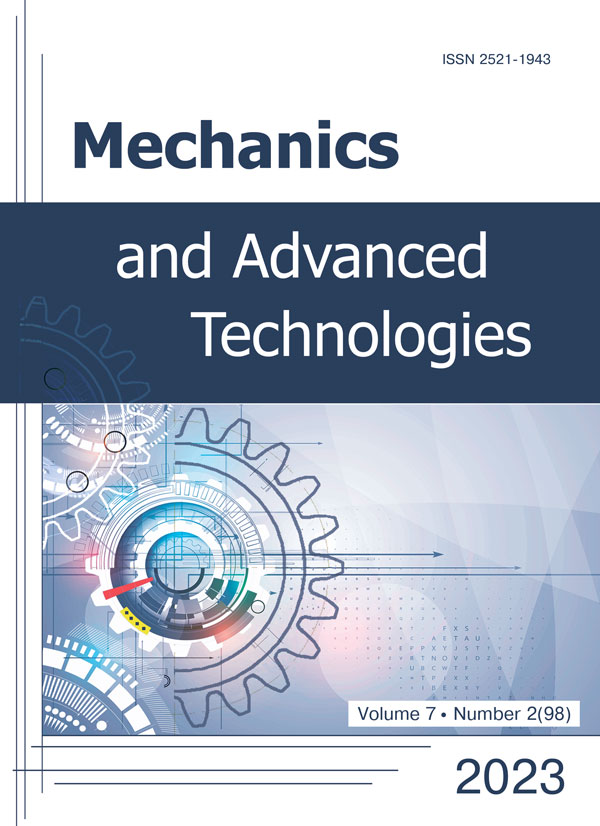Assignment of the cutting mode when boring holes on CNC machine
DOI:
https://doi.org/10.20535/2521-1943.2023.7.2.286123Keywords:
hole boring, stability lobes diagram, transient and frequency responsesAbstract
Due to structural limitations, the processes of boring holes are performed in a low-rigidity machining system, which predetermines their susceptibility to vibrations. The article is devoted to the study of the process of boring holes on CNC machines, and the subject of the study is the effect of the cutting mode on the stability of the machining. The mathematical model of the machining system is presented in the form of a two-mass dynamic system, which forms a closed loop structure with negative feedback by elastic displacement. In addition, positive feedback is taken into account through the delay argument function, which represents machining along traces. It has been proven that this process provokes the emergence of regenerative oscillations in the machining system. The application of the system’s approach made it possible to obtain a mathematical model in the form of state variables, which is acceptable for the use of numerical modeling methods in both time and frequency space. An applied engineering program for determining the stability diagram in "cutting depth - spindle speed" coordinates has been created. The program uses a new criterion of stability of systems closed through positive feedback loop with a delay argument function. For the first time, the validity of such a criterion was proved for systems described by differential equations of the fourth order. The importance of taking into account the results of the study in the form of a stability lobes diagram when assigning a cutting mode, especially in the area of high speeds, is proven. Thus, according to the results of the experiments, a change in speed of only 7% from 2150 rpm to 2320 rpm with the same cutting depth of 0.4 mm allows the process to become stable. The use of the created program is possible in the system of automatic control of the online cutting mode when the machine is equipped with vibration sensors with appropriate systems for identifying the dynamic parameters of the machining system, which will significantly increase the machining efficiency.
References
- Y. Altintas, G. Stepan, E. Budak, T. Schmitz and Z. M. Kilic, “Chatter Stability of Machining Operations”, Journal of Manufacturing Science and Engineering, vol. 142, no. 11, p. 110801, 2020. DOI: https://doi.org/10.1115/1.4047391.
- Y. V. Petrakov, “Chatter suppression technologies for metal cutting”, Mech. Adv. Technol., no. 2(86), pp. 51–60, Nov. 2019. DOI: https://doi.org/10.20535/2521-1943.2019.86.185849.
- A. Yadav, D. Talaviya, A. Bansal and M. Law, “Design of Chatter‐Resistant Damped Boring Bars Using a Receptance Coupling Approach”, Journal of Manufacturing and Materials Processing, vol. 4, no. 2, p. 53, 2020. DOI: https://doi.org/10.3390/jmmp4020053.
- BoreMeister - Vibration-Free Solution for Deep-Hole Boring. Available: https://youtu.be/i1bhiX1ldnE.
- Y. Alammari, M. Sanati, T. Freiheit and S. S. Park, “Investigation of Boring Bar Dynamics for Chatter Suppression”, Procedia Manufacturing, vol. 1, pp. 768–778, 2015. DOI: https://doi.org/10.1016/j.promfg.2015.09.059.
- Y. Petrakov and M. Sikailo, “Simulation of an Absorber of Vibration in Turning”, in Advanced Manufacturing Processes III: Selected Papers from the 3rd Grabchenko’s International Conference on Advanced Manufacturing Processes (InterPartner-2021), September 7-10, 2021, Odessa, Ukraine. Cham: Springer International Publishing, 2021, pp. 199-208. DOI: https://doi.org/10.1007/978-3-030-91327-4_20.
- P. Szulewski and D. Sniegulska-Gradzka, “Systems of automatic vibration monitoring in machine tools”, Mechanik, no. 3, pp. 170-175, 2017. DOI: https://doi.org/10.17814/mechanik.2017.3.37.
- A. M. Gouskov, S. A. Voronov, V. V. Novikov and I. I. Ivanov, “Chatter suppression in boring with tool position feedback control”, Journal of Vibroengineering, vol. 19, no. 5, pp. 3512–3521, 2017. DOI: https://doi.org/10.21595/jve.2017.17777.
- Y. Altintas, Manufacturing Automation: Metal Cutting Mechanics, Machine Tool Vibrations, and CNC Design, 2nd ed. Cambridge University Press, 2012, 366 p. DOI: https://doi.org/10.1017/CBO9780511843723.
- Y. Petrakov and M. Danylchenko, “A time-frequency approach to ensuring stability of machining by turning”, Eastern-European Journal of Enterprise Technologies, vol. 6, no. 2 (120), pp. 85–92, 2022. DOI: https://doi.org/10.15587/1729-4061.2022.268637.
- What is Hammer Testing? Available: https://www.sensorland.com/HowPage130.html.
- Fast Fourier Transformation FFT – Basics. Available: https://www.nti-audio.com/en/support/know-how/fast-fourier-transform-fft.
- E. García Plaza and P. J. Núñez López, “Analysis of cutting force signals by wavelet packet transform for surface roughness monitoring in CNC turning”, Mechanical Systems and Signal Processing, vol. 98, pp. 634–651, 2018. DOI: https://doi.org/10.1016/j.ymssp.2017.05.006.
- GARANT Machining Handbook. Available: https://www.cnc-trainer.com/download-ebook-garant-machining-handbook.html.
- Okuma’s Intelligent Technology: Machining Navi. Available: https://www.youtube.com/watch?v=EtRXNZgc6GU.
Downloads
Published
How to Cite
Issue
Section
License
Copyright (c) 2023 Yuri Petrakov, Mariia Danylchenko

This work is licensed under a Creative Commons Attribution 4.0 International License.
Authors who publish with this journal agree to the following terms:
- Authors retain copyright and grant the journal right of first publication with the work simultaneously licensed under CC BY 4.0 that allows others to share the work with an acknowledgement of the work's authorship and initial publication in this journal.
- Authors are able to enter into separate, additional contractual arrangements for the non-exclusive distribution of the journal's published version of the work (e.g., post it to an institutional repository or publish it in a book), with an acknowledgement of its initial publication in this journal.
- Authors are permitted and encouraged to post their work online (e.g., in institutional repositories or on their website) prior to and during the submission process, as it can lead to productive exchanges, as well as earlier and greater citation of published work











